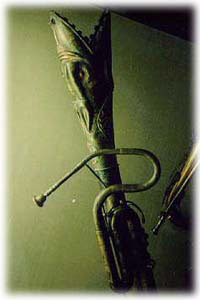 |
 |
|
|
Would you know of a useful resource where I may find explanations on the physical nature of a tuba and how its construction affects the sound of the tuba (i.e., lacquer vs. silver)(general and specific issues to consider). Is there typically a timbre contrast in piston and rotor tubas? Affect of bore size on tone production? Also very importantly, things that one must consider and examine on a tuba before purchasing it
|
|
Unfortunately, there is not a lot of information that I can direct you too. There are some facts covered in Clifford Bevan's book, The Tuba Family and you may locate a couple of articles if you consult Mark Fasman's book Brass Bibliography.
Basically, there's not much written that can be considered authoritative. You must realize that this is an area in which Acoustic Physics still says that 2 tubas made to the same specifications; one from brass and one from concrete, should play the same!! We are all aware that this is wrong, but the research has yet to be done. What we are left with is non-scientific 'feelings' of 1 player versus another. For example, some insist that Silver plate makes the tone darker while another group insists that it is brighter. Based on the research I have seen which was done at a German University for the Wenzel Meinl Company, it seems to have no effect. HOWEVER, the construction processes involved between preparing an instrument for silver plate or for lacquer ARE different and DO seem to contribute to an initial difference in the instruments. After a period of being played, the instruments then test as being the same.
The idea of discussing tuba bore size as a determining factor of tone, etc. is simply wrong. The tuba is a conical instrument. When the tuba is fitted with piston valves it has a shorter leadpipe....with rotary valves a longer leadpipe. The explanation of why would take longer than I have at the moment, but if you look at a few instruments, you will see that this is true. Since the instrument is tapered, the further into the taper you go, the larger the valve size must be. Since bore is measured at the slides, the bore size is actually a measure of the size of the valve ports. THEREFORE, if you build 2 tubas EXACTLY the same except use piston valves in one and rotary valves in the other, you actually will still have a change in leadpipe length and a result that the bore size of the piston instrument is measured as smaller than that of the rotary.
Bore size is beneficial information in comparing cylindrical instruments (trumpets and trombones) but only marginally useful in tubas PROVIDED you compare piston instruments to piston instruments or rotary instruments to rotary instruments.
There is not a clear difference in sound between piston and rotary tubas PROVIDED you are comparing similar quality instruments. There IS a difference in the response of the instrument. Generally piston instruments are felt by the player to be more open and faster responding. Generally rotary instruments are perceived has being 'smoother', particularly for slurs.
In purchasing an instrument, selection of key and size should come into play first. Very large instruments may be fun to play, but generally are not a good choice for solo/chamber performance. Smaller instruments work great for solo/chamber, but may lack the heft desired in orchestral/band performance. The first decision is one of 'What will be your MAIN performance medium'. Then consideration goes to sound and response. Also, one should consider and ask around, as to the construction reliability of the instrument. For example, there is currently an which plays really quite well when you first try it, but it is also NOTORIOUS for poor construction in terms of poor solder, bad plating, etc. What seems like a good price today, seems much worse after 1 year when the nickel plate is coming off the instrument and solder joints are beginning to come apart!!
|
|
 |
|
| |
|
DR.
FUN
|
|
| |
|
|